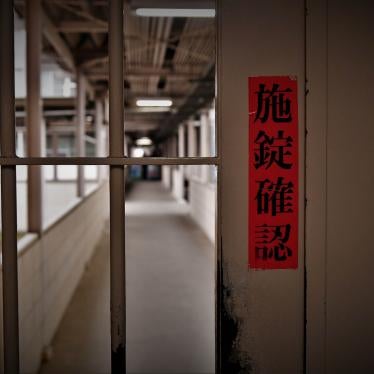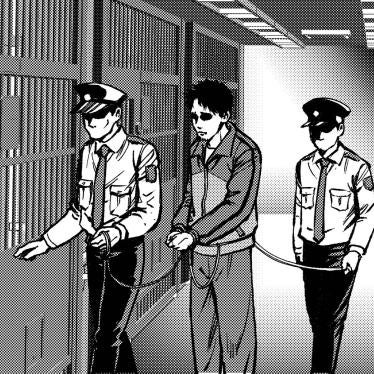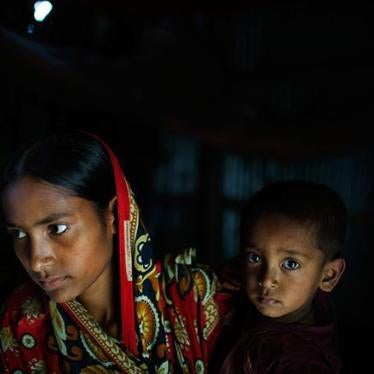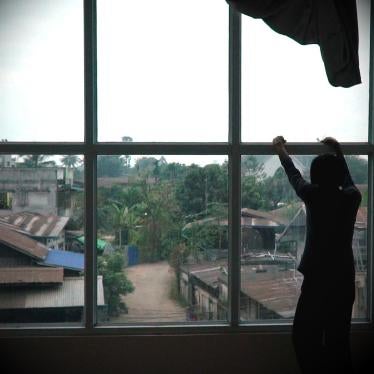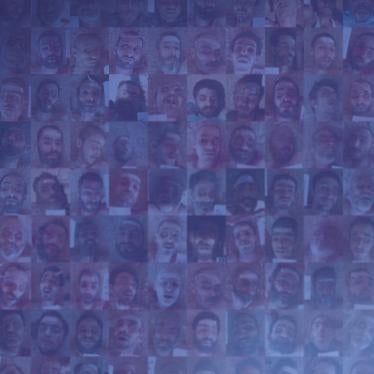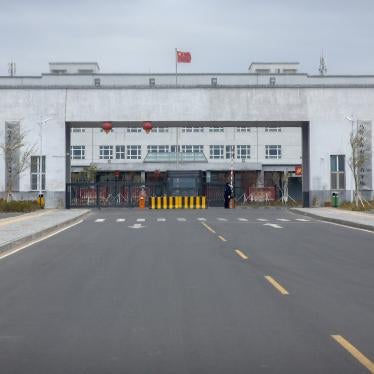(ニューヨーク)-シリア政府軍は過去3週間に、アレッポ県内で少なくとも10軒のパン屋とその周辺を空爆/砲撃し、パン屋前で行列していた多数の一般市民を殺傷した、と本日ヒューマン・ライツ・ウォッチは述べた。
こうした攻撃は、少なくとも重過失(reckless)の無差別な攻撃に該当するといえるが、そのパターンと頻度からして、政府軍が一般市民を標的にしていることを示唆している。重過失による無差別攻撃も意図的な一般市民への攻撃も、いずれも戦争犯罪に該当する。
2012年8月16日にアレッポ市内で行われた攻撃では、60人も殺害され、70人以上が負傷。他に8月21日に同市内であった攻撃でも、少なくとも23人が殺害され、30人が負傷している。
ヒューマン・ライツ・ウォッチ緊急対応部門の調査員ウレ・ソルバン(アレッポでの現地調査を終えたばかり)は、「来る日も来る日も、アレッポ県の人びとは家族のためにパンを求めて並ぶ。そうして、パンを手に入れるかわりに、政府軍の爆弾や砲弾の破片に体を貫かれている」と述べる。「パン屋が10軒も攻撃されたのは偶然ではない。政府軍は一般市民の命を完全に軽視しており、更には標的にしていると見られる節がある。」
ヒューマン・ライツ・ウォッチの調査陣は、攻撃を受けたパン屋のうち、次に挙げる6軒を訪れ、目撃者に聞き取り調査を実施した:
- アレッポ県北部Maareのパン屋(攻撃日は8月22日)
- アレッポ県北東部Al-Babのパン屋(攻撃日は8月21日と22日)
- アレッポ市内Bab al-HadidのAqyuolパン屋(攻撃日は8月21日)
- アレッポ市内Qadi AskarのAl-Zarraパン屋(攻撃日は8月16日)
- アレッポ市内al-MaysarのKanjouパン屋(攻撃日は8月16日)
- アレッポ市内al-Halwaniyaのパン屋(攻撃日は8月16日)
またヒューマン・ライツ・ウォッチは次に挙げるパン屋4軒に対する攻撃についても攻撃に関する信頼性の高い情報を入手した:
- アレッポ県北部Manbijのパン屋(攻撃日は8月24日)
- アレッポ市内al-QaterjiのHusseinパン屋(攻撃日は8月16日)
- アレッポ市内Tariq al-Babのパン屋(攻撃日は8月10日)
- アレッポ市内al-Sheikh Sa’id地区のパン屋(攻撃日は8月11日)
アレッポ県における政府軍と反体制派「自由シリア軍」の何週間にもわたる戦闘のために深刻な小麦粉不足に陥ったことから、多くのパン屋が閉店を余儀なくされた。営業を続けているパン屋の外には、市民がパンを求めて長い列を作っていることが多い。
ヒューマン・ライツ・ウォッチが調査して取りまとめた政府軍による攻撃は、マンビジ(Manbij)のパン屋への攻撃を除き、すべて地元住民が列をなして待っている際中に行われた。使用されたのは砲弾、ロケット弾、爆弾などで、列にかなり近い地点に着弾。弾薬の破片が人びとのいる所まで飛び散り、多くを殺傷した。列で待っていた人びとが戦闘機の接近する音を聞き、攻撃の前に逃げたケースもあった。
こうしたパン屋に対する攻撃の目撃者全員が、政府軍による事前警告はなかったと証言している。
10軒のパン屋は住宅地や町中にあり、攻撃前/攻撃時にその周辺で戦闘は起きていなかった。目撃者らの証言によると、自由シリア軍数名が秩序維持とパン配給の補助のために標的となったパン屋に待機していたケースが多く、大勢において自由シリア軍兵士が負傷したことはなかったという。
あるケースでは、自由シリア軍の施設がパン屋からおよそ150メートル離れた所にあったが、その施設は被害は受けなかった。ヒューマン・ライツ・ウォッチが調査した残りのケース5件では、数名の自由シリア軍戦闘員が秩序の維持をしているのが目撃されたのを除き、攻撃対象となった地域内における軍事目標は皆無だった。
多数の一般市民が現場に存在したことを考慮すれば、パン屋に戦闘員数名が存在しても攻撃は正当化されない。そこにいた少数の戦闘員を標的にするための措置や、一般市民への危害を最小限に抑えるための措置を、シリア政府は一切講じていないと見られる。いくつかのケースでは、攻撃前に当該地域上空をヘリコプターがホバリング(空中停止)しており、一般市民が存在していることをわかっていたはずである。
中でも最大の犠牲者を出した攻撃のひとつが、8月16日にアレッポ市内カディ・アスカール(Qadi Askar)居住区で行われた攻撃だった。午前5時45分ごろ、自由シリア軍の拠点が複数存在するカディ・アスカール居住区の広場に1、2発の砲弾が着弾。軍拠点のひとつが広場近くにあり、パン屋からは約150メートルほどだった。同軍の施設や隊員に被害はなかった。しかしその15分後、更に3発の砲弾が、数分間に連続して着弾。それは、数百の人びとがパンを求めて待つパン屋に更に近い場所だった。
3発目の砲弾はパン屋から数メートルしか離れていない通りに着弾し、列をなす人びとに破片を浴びせかけた。犠牲者の正確な数を把握するのは困難であるが、ヒューマン・ライツ・ウォッチが確認したダル・アルシファー(Dar Al Shifaa)病院の記録によると、身元の確認された遺体は49体、未確認の遺体は11体、ならびに負傷者は76人だった。ダル・アルシファー病院はこの攻撃による死傷者の大半を受け入れた病院である。
8月21日の攻撃では、アレッポ市内バブ・アラディド(Bab al-Hadid)にあるアキュオル(Aqyoul)パン屋の前にできていた行列を、ヘリコプターから投下された爆弾が直撃。少なくとも23人が殺害され、30人超が負傷した。その攻撃で負傷した仕立て屋の“ファイ”(44歳)はヒューマン・ライツ・ウォッチに次のように話した。
「パン屋の入り口の近くに立っていたら、爆弾が落ちた。両手で頭をかばいながら、命からがら逃げたよ。隣の店にかけ込んだ時になってはじめて、けがをしているのに気づいた。わき腹と左腕だ。」
「あたりはどこも黒い煙と割れたガラスでいっぱいだった。爆弾は通りの角に落ちて、破片がまっすぐ飛んできたんだ。だからそこにいた人は殺されたか、ひどいけがをしたよ。足がない男の人がひとり倒れていて、もうひとりは腕がなかった。それに知り合いの16歳、ラファト・マキク・ハラク(Rafat Makik Halak)の頭がふっとんでいるのも見た。いとこのひとりアフメドも腕と足をふきとばされて、その後死んだ。僕の姉(妹)もひとりけがをして、まだ病院にいるよ。」
(上記の攻撃を含む攻撃に関する更に詳細な情報については、文末をご覧ください)
国際人道法(戦争法)は、一般市民と民用物(軍用物でないものすべて)に対する直接攻撃および無差別攻撃を禁じている。戦争法は軍事行動の際、一般住民に被害を及ぼさないよう常に配慮し、偶発的な人命の犠牲と民用物の損壊を回避、または最小限に抑えるべく、「実行可能なあらゆる措置」を講じることを、全紛争当事者に義務づけている。こうした予防措置には、攻撃目標が文民あるいは民用物ではなく、軍事目標であることを確保するために実行可能なすべての手段を取ること、状況が許す場合に攻撃の「実効ある事前警告」を行うことなどが含まれる。
軍指揮官は、軍事目標を直接狙える攻撃法を選択する義務があり、一般市民に対する偶発的被害を最小限にとどめなければならない。使用する兵器の精度が低いために一般市民に対する被害の多大な可能性を含まずには軍事目標を狙えない場合には、それらの兵器を使用してはならない。「比例性原則」に觝触する攻撃もまた禁じられている。攻撃から期待される具体的かつ直接的な軍事的利益と釣り合わない、偶発的な文民の犠牲や民用物の損失が予想されうる攻撃は比例原則に反する不相応な攻撃に該当する。
重大な戦争法違反には、一般市民に危害をもたらす意図的攻撃、無差別攻撃、不相応攻撃が含まれる。犯意を持って—意図的あるいは重過失をもって—行われた違反行為は戦争犯罪にあたる。こうした攻撃を命令、ほう助あるいは共謀した司令官や文民の指導者は、戦争犯罪の刑事責任を問われる可能性がある。また、戦争犯罪行為が行われていることを知り、あるいは戦争犯罪が行なわれると知るべきであったにもかかわらず、戦争犯罪行為を防せいだり、責任者を処罰するための十分な措置を取らなかった場合も、上官責任を問われ、戦争犯罪で訴追される可能性がある。
10軒のパン屋は一般市民にパンを提供しており、この点において明らかに民用物だった。
前出のソルバン調査員は次のように指摘する。「パンを求めて並んでいた市民の列に意図的にロケット弾を撃ち込んだすべてのパイロット、そしてそのような命令を下したすべての指揮官が、自らの犯した罪で裁かれるべきだ。」
ヒューマン・ライツ・ウォッチは、ロシア政府と中国政府に対し、国連安全保障理事会によるシリア国民の保護活動を妨害しないよう強く求めた。安保理はシリアの事態を国際刑事裁判所(ICC)に付託すると共に、シリア政府に対する武器禁輸措置、ならびに人権侵害に関与した政府高官を対象とした制裁措置を発動すべきである。
パン屋前の攻撃の詳細
Al-Zarra bakery in Qadi Askar, Aleppo city, August 16
At around 5:45 a.m. on August 16, government-fired artillery shells struck near a FSA facility in the Qadi Askar neighborhood in Aleppo city. Witnesses told Human Rights Watch that between three and five minutes later, two shells hit apartment buildings in an area on the other side of the street from the al-Zarra bakery. A fourth shell exploded in the street a few meters from the breadline where several hundred people were waiting in line on both sides of the entrance.
The exact number of casualties is difficult to verify. Several witnesses who were at the bakery at the time of the attack, or who arrived immediately thereafter to help the wounded, said they saw between 35 and 50 dead people. Records viewed by Human Rights Watch at the Dar Al Shifaa hospital, where most of the wounded and dead were taken, list 49 identified and 11 unidentified bodies received that day, as well as 76 injured people. Human Rights Watch was not able to verify whether all of the killed and injured recorded by the hospital came from the attack at the al-Zarra bakery.
Human Rights Watch visited the site of the attack and examined the place where the last shell exploded. At the time of Human Rights Watch’s visit, hundreds of people were waiting in front of the still-functioning bakery.
“Samir,” who lives across the street, told Human Rights Watch that at just before 6 a.m. he heard a whistling sound and an explosion, and he ran out to see what happened:
There were between 40 and 50 people on the ground, covered in blood, and body parts – arms and legs all over. I remember a little boy, maybe five years old, killed, his head split open, and there was still a piece of bread in his mouth. The FSA brought a truck to take the dead and injured away – there were too many of them.
“Fadi,” who lives in a building on the other side of the street from the bakery told Human Rights Watch:
When the shelling started we went to the basement. Suddenly there was a huge explosion. We thought that the shell had hit our building. When I went out to see what happened I saw a lot of dead bodies on the street – there were at least 15. Others died later from their injuries. People were yelling. The FSA, who had arrived to help the injured, told us to forget about the dead and focus on the injured. We loaded the injured up on cars and sent them to the hospital.
Kanjou bakery, al-Maysar neighborhood, Aleppo city, August 16
Around 10 p.m. on August 16, three artillery shells landed outside the Kanjou bakery in the al-Maysar neighborhood in Aleppo city while civilians were lining up for bread. Three witnesses said the first shell struck about 30 meters from the bread line, damaging an ambulance. The second shell hit the other side of the street, and the third shell hit close to the breadline. Witnesses said that there was less than a minute between the first and third shell. The attack killed an elderly woman and wounded 17 people, including six FSA fighters who were organizing the bread line.
One FSA fighter whose right arm was wounded in the attack told Human Rights Watch:
After the attack on the Qadi Askar bakery that same morning we had become very nervous about bakeries. But people lined up anyway – they need bread. When the first shell struck, however, everybody fled. There were several children among the wounded.
The FSA fighter told Human Rights Watch that a helicopter had been circling above just before the attack, raising the possibility that the helicopter had located the gathering of people for the artillery unit. A group of local residents on the street gave a similar description of the attack.
The following day, August 17, a jet struck the same bakery directly with a rocket, causing significant damage but no casualties because the bakery was closed.
On August 20, a bomb dropped by a jet struck two buildings on either side of a nearby street parallel to the one with the bakery, killing 12 people and wounding 20 to 25 according to local residents. The residents said that those killed included four members of the Hidani family, ages 10, 16, 16, and 75, whose house was struck by the bomb. Six of the other victims were killed in the street as they were fleeing from the bakery after hearing the jet. Among the wounded were seven children and five women from the Hidani family.
The bomb hit a building on one side of the street, destroying the top floor, and another building on the other side of the street, destroying its lower floors. The damage to the two buildings, examined by Human Rights Watch, indicates that the bomb might have been intended for the bakery, but fell short. Residents in the street interviewed by Human Rights Watch believed that the jet had attempted to target the bakery.
One resident told Human Rights Watch:
When they heard the jet people knew that the bakery could be targeted so they ran to hide in our street. The bomb fell short, however, striking our street instead of the bakery.
When Human Rights Watch visited the area two days after the attack, four FSA fighters were sitting across from the bakery, but there were no indications of any other military activity in the area. According to the FSA soldiers, the nearest FSA base is 400 meters away.
Aqyoul bakery in the Bab al-Hadid neighborhood, Aleppo city, August 21
At around 6 p.m. on August 21, a helicopter dropped two bombs near Aqyoul bakery in the Bab al-Hadid neighborhood in Aleppo city. One bomb struck the edge of a building on the opposite side of the street where people were lining up in front of the bakery; the second hit about 50 meters away. The attack killed at least 23 people, and wounded more than 30.
Human Rights Watch reviewed several videos made by witnesses immediately after the attack and interviewed the people who had filmed videos. One shows a helicopter circling over the area immediately before the attack. Another video shows the aftermath of the attack: a line of what appears to be either dead or heavily injured people along the wall of the bakery where people were waiting for bread. Many more bodies, some with limbs and heads blown off, can be seen on the ground around the bakery. A 17-year-old boy who shared the video with Human Rights Watch, said:
In the afternoon there was a helicopter circling above the area for about 4 hours. I thought it was strange and so I took my camera and started filming. Around 6 p.m., when the attack happened, I was just 20 meters away from the bakery. I saw the bomb falling and ran for cover. The bomb hit the building in front of the bakery, and then the street. I went out to film – I cannot describe it. It was the worst I’ve ever seen.
“Fais,” a 44-year-old tailor, who worked as a volunteer at the bakery and was wounded in the attack, told Human Rights Watch that in the afternoon he had delivered flour to the bakery and was about to leave when the attack took place:
There were about 200 people near the bakery, standing in line. I heard the helicopter, and started telling people that there was no more bread left – I just wanted them to leave, away from danger. Many left but for others it was too late. I was standing near the door of the bakery when the bomb hit – I just covered my head with my hands and ran for my life. I ran into a store next door and only there I realized that I was injured – in my side and left arm.
There was black smoke everywhere, and broken glass. The bomb hit the corner of the street, and the shrapnel flew straight into the line – everyone there was either killed or heavily injured. I saw one guy on the ground without a leg, another without an arm, then a 16-year-old boy whom I knew, Rafat Makik Halak, without a head… One of my cousins, Ahmed, lost his arm and leg, and died afterward. My sister, who was also injured, is still in the hospital.
Another witness told Human Rights Watch that his brother, 22-year-old Muhammad Bashir Saqal, died in the attack:
I was in our house, close to the bakery, while my brother was standing in line. At around 6 p.m., I saw the helicopter coming low, and then heard a big blast – the entire building shook, and we all ran to the basement. I waited about 20 minutes and then came out to help the injured. I first found one of my cousins who was injured, and just as I managed to get him to one of the cars that were taking the wounded to the hospital, someone told me that my brother was injured as well.
We found him – he was injured in the neck and in his stomach – and my father together with another cousin tried to get him to the hospital. But he died on the way. On the way to hospital, there was a shabeeha [pro-government militia] checkpoint. They stopped the car, and arrested my father and cousin, and took my brother’s body away. They were released two days later, and then my father found out that Muhammad’s body was buried near the [government-controlled] university hospital. We still need to go there and find his grave.
One of the FSA fighters who participated in the rescue operation, told Human Rights Watch that they took 21 dead bodies and 3 people with lethal injuries as well as the other wounded people to Dar Al Shifaa hospital, but that the hospital was full so they had to send some of the bodies and wounded people to the government-controlled Razi hospital. According to records viewed by Human Rights Watch at Dar Al Shifaa hospital, the hospital received 17 dead bodies, 3 of them unidentified, from the Bab al-Hadid bakery attack. The hospital transferred 29 wounded people and 5 dead bodies to another hospital. One of the wounded, a child, died shortly thereafter, and another five, with very serious wounds, had little chance of survival, the hospital staff told Human Rights Watch.
FSA fighters in the neighborhood said that on the morning of August 21 they were engaged in a fight with government forces a kilometer or two from the bakery, but that there was no fighting near the bakery. They believed that government forces, after trying to push the FSA back for several hours, decided to use a helicopter attack against the bakery to draw the FSA forces away from the fight.
Bakery in al-Halwaniya, Aleppo city, August 16
Local residents in al-Halwaniya told Human Rights Watch that 11 people, between 11 years old and 60, were killed when an artillery shell struck the bakery building around 6 p.m. on August 16. Human Rights Watch was not able to interview the residents in detail because of the precarious security situation, but staff at Dar Al Shifaa hospital confirmed the attack, providing Human Rights Watch with the names of six of the people who were killed.
Bakery in Maare, Northern Aleppo, August 22
On August 22, at around 9.30 am, a fighter jet attacked a bakery in the town of Maare in northern Aleppo province, witnesses told Human Rights Watch. The jet fired a rocket and then dropped a bomb near the bakery in the eastern part of town. According to three witnesses, about 300 people were in line at the time of the attack. Human Rights Watch visited the site and saw a crater where the rocket hit, about 35 meters from the bakery.
There were no casualties from the attack as most people fled when they saw the jet, and the bomb did not explode – it landed 30 meters from the bakery. Human Rights Watch saw no FSA activity or facilities anywhere in the vicinity; two known FSA facilities in Maare are located in other parts of town.
Bakery in Al-Bab, northeast Aleppo province, August 21 and 22
A bakery on the outskirts of the town of Al-Bab in northeastern Aleppo province was bombed by fighter jets at least three times: at 4 p.m. and 11 p.m. on August 21, and around 11 p.m. on August 22.
The attacks on August 21 did not cause casualties. Witnesses told Human Rights Watch that during the first attack nobody was near the bakery. During the second attack, people who were waiting in line – about 20 men and 10 women – ran away as soon as they saw the jet approaching and nobody was wounded.
On August 22, the jet dropped two bombs near the bakery. Human Rights Watch visited the site of the attacks and examined the craters. One was about 10 meters from the bakery and one about 50 meters away. Witnesses told Human Rights Watch that most of the people who were waiting in line fled when they saw the jet, but that three men and one boy were wounded.


